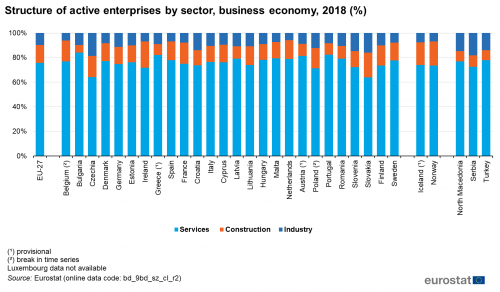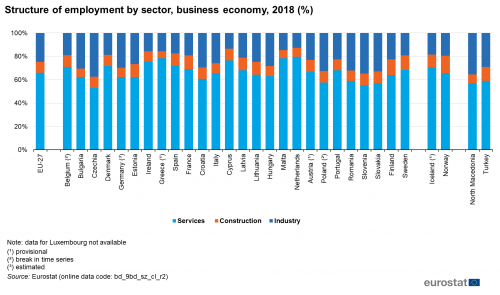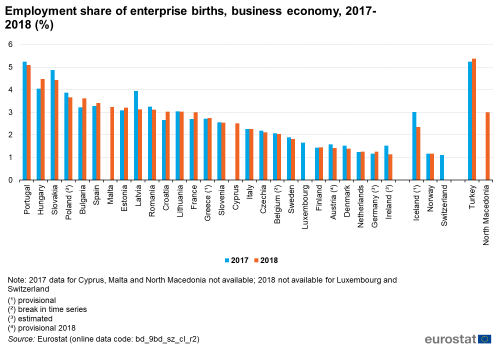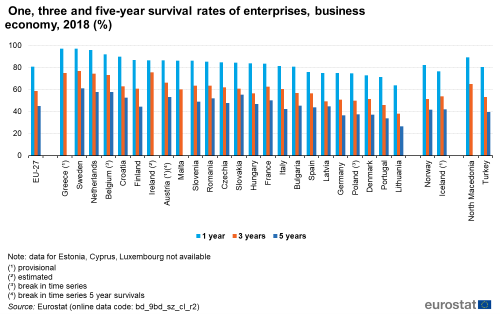How Many Registered Businesses Are There In The World
General overview
In 2018, the EU-27's business economic system was made upwardly of 25.three 1000000 agile enterprises with more than 131 million persons employed. The largest agile enterprise population was registered in France (4.0 million) and Italy (3.8 million), followed by Espana (3.ane 1000000) and Deutschland (two.7 million). The services sector was dominant in every state, as measured past the highest proportion of active enterprises.
There were nigh 3.iii million jobs created from about ii.5 million newly born enterprises, based on the final 2018 data. The number of newly-born enterprises in 2018 increased by more 140 000 enterprises compared with 2017. The one-year survival rate for enterprises created in 2017 was more than 80 %. The highest shares of high-growth enterprises in 2018 were reported in Greece, the Netherlands and Spain.
Active enterprises in the business economy
This section provides an overview of the business concern enterprise population. It is based on aggregated data for industry (Sections B to E), construction (Section F) and services (Sections Thousand to Due north, excluding activities of holding companies – K64.2), according to NACE Rev. 2. In 2018, looking at EU level, three quarters (76 %) of all enterprises active in the concern economy (NACE Rev. 2 Sections B to N, excluding K64.2) were inside the services sector, providing work for about two thirds of the total number of persons employed (see Figures 1 and ii). Services accounted for between 63.9 % of the number of all enterprises in the business economy in Slovakia and 84.1 % of the total in Bulgaria. In terms of its contribution to employment, the services sector accounted for 52.9 % of the workforce in Czech republic, while kingdom of the netherlands had the highest share at 79.7 %.

Figure 1: Structure of agile enterprises by sector, business economy, 2018 (%)
Source: Eurostat (bd_9bd_sz_cl_r2)

Figure 2: Structure of employment past sector, business economy, 2018 (%)
Source: Eurostat (bd_9bd_sz_cl_r2)
Past dissimilarity, simply nine.seven % of active enterprises in the Eu were found in industry, fifty-fifty though these enterprises provided piece of work for more than 32 meg persons. The boilerplate size of industrial enterprises (as measured in terms of the number of persons employed) was considerably higher in industry than for services. Indeed, industrial enterprises employed xiii persons on average across the 27 Member States, compared to an boilerplate of five persons for services. The average number of persons employed in construction was the everyman, with three persons per enterprise.
Birth rate
The birth of new enterprises is often seen every bit one of the key determinants of chore creation and economic growth. Enterprise births are thought to increment the competitiveness of a land'due south enterprise population, by obliging them to get more efficient in view of newly emerging competition. As such, they stimulate innovation and facilitate the adoption of new technologies, while helping to increase overall productivity within an economy.
Looking at nascence rates in the EU, the number of newly born enterprises as a proportion of the full number of active enterprises increased somewhat in 2018 compared with 2017. The nascence rates ranged from four.7 % in Greece to 19.0 % in Lithuania, while staying close to the European union 2018 average in Croatia, Espana and the Netherlands. The nascence rate was low in Greece, Sweden, Austria and Belgium for 2017 and 2018. At the other end of the scale, high birth rates for both years were recorded in Lithuania and Portugal. The comparison of the two years reveals that the birth rate has increased in 15 of the Member States and decreased in 10 Member States (Figure 3).

Figure 3: Enterprise birth rates, business organisation economy, 2017 - 2018 (%)
Source: Eurostat (bd_9bd_sz_cl_r2)
While the report of enterprise nativity rates provides useful information on the dynamism in the economy, the event on the labour market is an important attribute, as an indicator of the potential task creations. Figure 4 shows the share of newly born enterprises in total employment of active enterprises, in terms of number of persons employed. In the total business economy in 2018, the employment share ranges from 1.one % (Ireland) to 5.1 % (Portugal). Portugal is the only land that had a share to a higher place v % in 2017 and 2018, whereas relatively depression shares were recorded for both years in Republic of ireland, Frg, the netherlands and Kingdom of denmark.

Figure four: Employment share of enterprise births, business economic system, 2017-2018 (%)
Source: Eurostat (bd_9bd_sz_cl_r2)
The data show that those countries with relatively depression/high birth rates too tended to report relatively low/high employment shares.
Enterprise survival charge per unit
The aim here is to nowadays information about the life bicycle of newly born enterprises and the ability to survive up to v years after their creation. The 2012 business concern demography information collection enabled the tracking of newly born enterprises over a five-twelvemonth period, tracing how many of them accept survived during that period. Figure v shows the one, three and 5-twelvemonth survival rates of enterprises in 2018.

Figure five: One, three and five-year survival rates of enterprises, business economy, 2018 (%)
Source: Eurostat (bd_9bd_sz_cl_r2)
Looking at the i-year survival charge per unit, it appears that, for the business economic system, more than than eighty % of the enterprises born in 2017 had survived in 2018. The highest ane-year survival rates were recorded for the concern economy in Hellenic republic (96.9 %) and Sweden (96.8 %), with rates also to a higher place 90 % in the Netherlands and Belgium. The lowest rates were reported in Lithuania (63.vi %) and Portugal (71.3 %).
Subsequently, twelvemonth-on-year survival rates posted a gradual fall in the majority of the countries. The v-yr survival rate of enterprises built-in in 2013 and still agile in 2018 shows that typically less than half of them survive for a five-year menses. Enterprises born in 2013 in Sweden, the Netherlands and Belgium were most likely to survive upwardly to the fifth twelvemonth after their nascency, while those in Lithuania ran the greatest risk of non-survival. In principal, non-survivals may be due to bodily deaths, indicating the deterioration of business environment, simply also due to break-ups or mergers.
Given that the survival rates logically subtract over 5 years in all the countries for which data were available, it is still interesting to expect at the employment changes in a five-year fourth dimension frame. For each country in Effigy vi, the second bar shows the change in employment. In only seven EU Member States (the Netherlands, Finland, Malta, Denmark, Bulgaria, Italy and Germany), along with Norway and Iceland, did employment increase in those enterprises that survived for v years. The largest decreases were noted in Czechia and Slovakia.

Figure vi: Enterprises surviving a v-year menstruation, business economy, 2018 (%)
Source: Eurostat (bd_9bd_sz_cl_r2)
High growth enterprises
High growth enterprises (growth in employment past 10% or more) play an important function in the contribution to economic growth and the creation of jobs. In 2018, around 172 000 companies, or more than a 10th (xi.9 %) of all active enterprises with at least x employees in the EU-27 business economy were recognised as high-growth enterprises, providing work for 13.9 million employees.
In 2018, considerable variations were observed across Eu Member States in the distribution of loftier-growth enterprises (Effigy 7). The shares ranged from over 16.9 % in Greece to less than three % in Romania.

Figure 7: High-growth enterprise shares in EU Member States, 2018 (%)
Source: Eurostat (bd_9pm_r2)
High-growth enterprises have a noteworthy impact on employment. In 2018, the highest contributions to the total number of employees with more than 20 % were recorded in kingdom of the netherlands, Greece, Ireland. Portugal, Spain and Hungary. Past contrast, the lowest shares in 2017 were registered by Belgium (half dozen.0 %), Romania (6.9 %) and Austria (9.0 %).
Although loftier-growth enterprises operate in all sectors of the concern economy beyond the Eu, their share in services is higher in the majority of Fellow member States. Looking at a breakdown by economic activity (Figure 8), high-growth enterprises in 2018 were more predominant in the service sectors, with the highest proportion in "Data and advice" (18.0 %), followed past "Authoritative and support service activities" (xv.eight %), "Transportation and storage" (fourteen.1 %) and "Professional, scientific and technical activities" (13.3 %). The start industrial sector in terms of proportions of high-growth enterprises was "Water supply; sewerage, waste management and remediation activities" (11.2 %) and the last with the lowest overall figures were "Electricity, gas, steam and air workout supply" and "Real estate activities" (both 8.0 %).

Figure 8: High-growth enterprise shares by economic sectors in the EU, 2018 (%)
Source: Eurostat (bd_9pm_r2)
Data sources
Business census data has been collected on a voluntary footing since 2002.
With the adoption of the recast SBS Regulation, business organisation census information collection has become role of the regular annual collection of structural business statistics. Afterward the recently adopted amendments, employer business census and loftier growth enterprises (growth by 10% or more than) are also compiled regularly each yr.
Annex IX of the recast structural business statistics Regulation provides a detailed module for the collection of statistics on business census. It requires the national statistical institutes (NSIs) to produce statistics on enterprise births, deaths and survival, using common definitions and methodology, which should ensure greater comparability in this field of statistics from the reference year 2008 onwards. Note that up to 2007, the statistics presented for this subject have been produced and provided by most of the NSIs on the basis of informal, gentlemen's agreements.
Context
Business demography is an important subject for policy-maker discussions nearly increasing the level of employment, since it is 1 of the chief priorities of the EU growth strategy.
Enterprise demography reflects, to some degree, the dynamism of the EU economic system through the adaptation of economic structures to changing market conditions. The potential contribution that enterprise creation tin can make to employment is also ane of the most important aspects drawing the attention of policy makers to the subject of enterprise census. In this context, enterprise creation can be seen as an indicator of competitiveness, as a gene of economical growth and equally a vital means of creating jobs.
Business census provides information for births, deaths and survival rates of enterprises, as well every bit information on related employment information. The two main measures used for employment are the number of persons employed and the number of employees.
The demography of the business population is represented by data on:
- the active population of enterprises;
- their birth;
- their survival (followed up to five years after birth);
- their death.
Particular attention is paid to the impact that these demographic events have on employment levels. Business demography information can be used to analyse the dynamics and innovation of different markets, such as:
- entrepreneurship in terms of the propensity to start a new business organization, such every bit analysed in the joint OECD/Eurostat Entrepreneurship Indicators Programme;
- how newly-born enterprises can contribute to the cosmos of jobs.
Source: https://ec.europa.eu/eurostat/statistics-explained/index.php/Business_demography_statistics
Posted by: richardsonfarturen.blogspot.com


0 Response to "How Many Registered Businesses Are There In The World"
Post a Comment